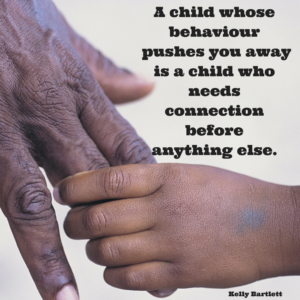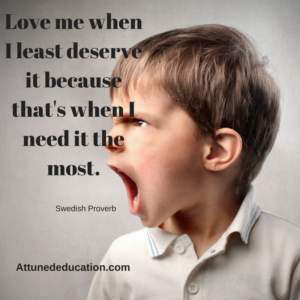Getting Behind the Behaviour – Five Questions to ask You rself
October 28, 2017
Behaviour is a form of communication. Someone slams a door – you know they are angry (unless there was a gust of wind!), if someone is tearful you infer they are upset. Of course behaviour isn’t just those big gestures lots can be conveyed by the way a person stands, their tone of voice, their demeanour and facial expressions.
Yet when we come to think about behaviour, especially behaviour in children and teenagers we so often seem to concentrate on what they do, rather than why they do it.
Clearly whatever age a child is, part of social learning is developing an understanding that particular behaviours lead to particular consequences, as adults we are well aware of that and we know they are not always pleasant, if we drive too fast, and get caught, we’ll pay a fine, if we display anger in certain ways at work, we may lose our jobs and I’m sure you can think of plenty of other examples. But simply responding to behaviour by imposing sanctions or consequences doesn’t teach a child an alternative way of behaving and does nothing to get behind the behaviour and understand why a child or young person is behaving in a particular way. So next time the behaviour is proving to be a challenge try asking these questions.
Can they behave in a different way?
In many ways as parents we accept the ‘toddler tantrums’ – the behaviour can be hard to manage and embarrassing when you are in the supermarket but often it is accepted, or perhaps tolerated is a better word, because we know it is a normal phase of development for many toddlers. Often it comes about when they are not able to express verbally how they feel, they don’t have the reasoning skills and they express their frustrations or distress in the only way they know how.
With older children or teenagers behaving in ways which are unacceptable, ask yourself if they can, as in are capable of behaving differently. Have you seen them handle a situation and not behave in this way? If the behaviour you see is always the behaviour you see in that situation then maybe they lack the maturity, or skills, to behave differently. It doesn’t mean the behaviour is acceptable but unless they are taught different ways of handing the situation or emotions then it seems a bit unfair to impose sanctions. You wouldn’t punish a child for not being able to feed themselves if they’d never had the opportunity to learn.
What skills do they need to learn?
The next stage is to identify the skills they need. Maybe they need help in identifying appropriate ways of expressing their emotions, anger, sadness, or frustration etc. It’s not easy even as an adult sometimes, so much less so for a child or teenager. They need to understand and be able to identify what they are feeling and then learn ways of expressing those feelings in a way that doesn’t hurt themselves or others. It is important to express the emotion not just suppress it or squash it down – that almost always leads to other problems in the future.
How do YOU manage that emotion?
As adults, especially as parents and teachers or school staff it is our role to give children the strategies they need to not just survive but thrive in the world. So as adults faced with a child who is displaying challenging behaviour we need to teach them some alternative strategies for dealing with those emotions. In the way we do with small children when we encourage them not to shout or cry but explain what the problem is (not in a whiny voice!!) we are saying ‘instead of doing what you are doing, try this.’ So if the behaviour appears to be in response to an emotion identify the emotion and then try to give them an alternative way of managing. What do you do when you are angry or upset, probably you don’t hit people or throw things, but you may leave the room for a while, go for a walk or explain why you are angry with a person or situation and being listened to will often help. Perhaps you use mindfulness, or exercise or offloading to a friend – think about what you do and try to think of a way that a child or young person could use a similar strategy.
Is the trigger really the trigger?
When we stop to consider why a behaviour is happening it can also be helpful to think what triggered it. But I also think we have all had situations when we have responded, apparently TO a particular trigger but actually the cause was really something else. Many people reading this will have experienced a bad day at work then, when they go home, they find something that would usually be mildly irritating but instead find themselves getting really cross over it. We have probably all taken things out on people that weren’t actually part of the problem. Sometimes it is a ‘last straw’ situation or sometime it’s because we feel safe with that person. Beware of identifying triggers though without observations over a period of time. Often what appears to be the trigger may almost incidental- a child who reacts negatively to losing a game may do so out of the frustration of the moment but may also do so because of some slightly bigger issue, the older sibling always winning, a sense of unfairness or because they feel useless at a particular thing, or even fearful of something.
Are they really choosing to behave that way?
Think again about yourself as a responsible, socially well-functioning adult. If you are put in a situation where you feel uncomfortable does that ‘make’ you do things you wouldn’t normally. You are at a party and hating it, do maybe tell a fib to give a reason to escape? Someone cuts you up when you are driving do you shout or gesticulate? You are faced with something you fear, a spider for example do you scream and demand that someone else deals with it? Someone says something to you that touches a nerve or raw spot and you react in an over the top way?
These are all examples of times when we maybe don’t use our usual, rational approach but rather we are ‘driven’ by the emotions the circumstances generate for us, or even other emotions we are experiencing at the time which cause us to behave in ways that are maybe not our usual, characteristic way of behaving. Probably we have all had incidents like this. We are not alone. A child who feels physically, but more usually emotionally, unsafe may react in extreme ways. They aren’t necesarily ‘choosing’ they are responding to the fear – a child refusing to try something because they are afraid they might fail then if pushed will behave angrily for example.
Children and young people won’t always behave the way we’d like them to but trying to get behind the behaviour will help you help them to develop new strategies. Asking yourself the questions above can help in that process.



